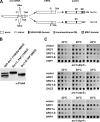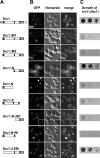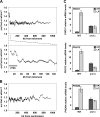The inner nuclear membrane protein Src1 associates with subtelomeric genes and alters their regulated gene expression
- PMID: 18762579
- PMCID: PMC2528585
- DOI: 10.1083/jcb.200803098
The inner nuclear membrane protein Src1 associates with subtelomeric genes and alters their regulated gene expression
Abstract
Inner nuclear membrane proteins containing a LEM (LAP2, emerin, and MAN1) domain participate in different processes, including chromatin organization, gene expression, and nuclear envelope biogenesis. In this study, we identify a robust genetic interaction between transcription export (TREX) factors and yeast Src1, an integral inner nuclear membrane protein that is homologous to vertebrate LEM2. DNA macroarray analysis revealed that the expression of the phosphate-regulated genes PHO11, PHO12, and PHO84 is up-regulated in src1Delta cells. Notably, these PHO genes are located in subtelomeric regions of chromatin and exhibit a perinuclear location in vivo. Src1 spans the nuclear membrane twice and exposes its N and C domains with putative DNA-binding motifs to the nucleoplasm. Genome-wide chromatin immunoprecipitation-on-chip analyses indicated that Src1 is highly enriched at telomeres and subtelomeric regions of the yeast chromosomes. Our data show that the inner nuclear membrane protein Src1 functions at the interface between subtelomeric gene expression and TREX-dependent messenger RNA export through the nuclear pore complexes.
Figures









Similar articles
-
Beyond Tethering and the LEM domain: MSCellaneous functions of the inner nuclear membrane Lem2.Nucleus. 2016 Nov;7(6):523-531. doi: 10.1080/19491034.2016.1252892. Epub 2016 Oct 31. Nucleus. 2016. PMID: 27797637 Free PMC article. Review.
-
Kar5p is required for multiple functions in both inner and outer nuclear envelope fusion in Saccharomyces cerevisiae.G3 (Bethesda). 2014 Dec 2;5(1):111-21. doi: 10.1534/g3.114.015800. G3 (Bethesda). 2014. PMID: 25467943 Free PMC article.
-
ESCRTs breach the nuclear border.Nucleus. 2015;6(3):197-202. doi: 10.1080/19491034.2015.1035844. Epub 2015 May 5. Nucleus. 2015. PMID: 25942571 Free PMC article.
-
The inner nuclear membrane proteins Man1 and Ima1 link to two different types of chromatin at the nuclear periphery in S. pombe.Nucleus. 2012 Jan-Feb;3(1):77-87. doi: 10.4161/nucl.18825. Nucleus. 2012. PMID: 22156748
-
Evolvement of LEM proteins as chromatin tethers at the nuclear periphery.Biochem Soc Trans. 2011 Dec;39(6):1735-41. doi: 10.1042/BST20110724. Biochem Soc Trans. 2011. PMID: 22103517 Free PMC article. Review.
Cited by
-
Nuclear envelope morphology constrains diffusion and promotes asymmetric protein segregation in closed mitosis.J Cell Biol. 2012 Jun 25;197(7):921-37. doi: 10.1083/jcb.201112117. Epub 2012 Jun 18. J Cell Biol. 2012. PMID: 22711697 Free PMC article.
-
Origin, conservation, and loss of alternative splicing events that diversify the proteome in Saccharomycotina budding yeasts.RNA. 2020 Oct;26(10):1464-1480. doi: 10.1261/rna.075655.120. Epub 2020 Jul 6. RNA. 2020. PMID: 32631843 Free PMC article.
-
Effects of Perinuclear Chromosome Tethers in the Telomeric URA3/5FOA System Reflect Changes to Gene Silencing and not Nucleotide Metabolism.Front Genet. 2012 Aug 2;3:144. doi: 10.3389/fgene.2012.00144. eCollection 2012. Front Genet. 2012. PMID: 22876257 Free PMC article.
-
Networking in the nucleus: a spotlight on LEM-domain proteins.Curr Opin Cell Biol. 2015 Jun;34:1-8. doi: 10.1016/j.ceb.2015.03.005. Epub 2015 Apr 10. Curr Opin Cell Biol. 2015. PMID: 25863918 Free PMC article. Review.
-
The tethering of chromatin to the nuclear envelope supports nuclear mechanics.Nat Commun. 2015 Jun 15;6:7159. doi: 10.1038/ncomms8159. Nat Commun. 2015. PMID: 26074052 Free PMC article.
References
-
- Akhtar, A., and S.M. Gasser. 2007. The nuclear envelope and transcriptional control. Nat. Rev. Genet. 8:507–517. - PubMed
-
- Alberola, T.M., J. García-Martínez, O. Antúnez, L. Viladevall, A. Barcelo, J. Ariño, and J.E. Pérez-Ortín. 2004. A new set of DNA macrochips for the yeast Saccharomyces cerevisiae: features and uses. Int. Microbiol. 7:199–206. - PubMed
-
- Brachner, A., S. Reipert, R. Foisner, and J. Gotzmann. 2005. LEM2 is a novel MAN1-related inner nuclear membrane protein associated with A-type lamins. J. Cell Sci. 118:5797–5810. - PubMed
Publication types
MeSH terms
Substances
LinkOut - more resources
Full Text Sources
Molecular Biology Databases
Miscellaneous

